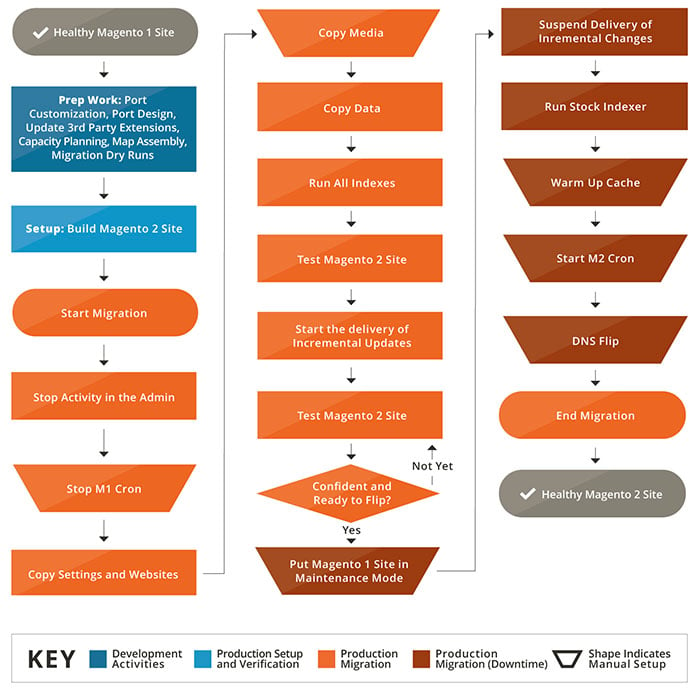Magento has emerged as the number one platform for eCommerce solutions. Many retailers, business owners and entrepreneurs are seeking to take their business to the next level with Magento.
Migrating from an existing store or starting a new one from scratch on Magento will certainly require a professional Magento developer and a learning curve. However, considering the benefits and the increasing popularity of such a platform, all your effort will be worth it! So, what exactly are the benefits of migrating from Magento 1.9 to 2.x? Let’s find out.
Benefits Of Migrating From Magento 1.9.x to 2.x
Magento 2 brings fundamental changes in the well-known eCommerce platform. It has major improvements in the following terms:
- On a technological level
- In modularity (both backend and frontend)
- Performance
In terms of long-term business productivity and growth, Magento 2 migration would prove beneficial in the following cases:
- The current eCommerce store has performance issues
- There is a plan to establish a new eCommerce business
- There is a need to implement bigger modifications
- The current system is running smoothly but is on an outdated version
Although, migrating is never painless, even when you’re migrating between two versions of the same system, upgrading from Magento 1.9.x to Magento 2 can offer you the following benefits:
Scalability and Enhanced Performance
Magento 2 loading time is way faster than the standard 2-3 seconds. The homepage, category pages, and product pages load in less than 1.5 seconds, even without using front-end caching.
Responsive and Search Engine Friendly
Magento 2’s responsive front-end design makes it easy to browse on all devices. This falls within Google’s algorithms which favor mobile-friendly websites for ranking. This responsive design also enhances the user experience.
Streamlined Checkout
With the new and streamlined checkout, the checkout process has become easier and faster for customers. Checkout is available for guests without registration and Magento 2 automatically identifies registered customers based on their email addresses.
Elasticsearch
Elasticsearch has improved the quality of searches and user experience. Third party Elasticsearch extensions for M2 are also available with similar functionality.
Cheaper and Easier Extension Updating
Magento is already counted over Drupal and WooCommerce for eCommerce development. And now, it’s latest version makes it even better. Compared to Magento 1.9.x versions, installing new extensions and modules has become simpler and thus cheaper too. The process has become simpler, as well as the front-end development, the functionality can be modified more easily too, thanks to HTML5, Less, require.js, and CSS3.
Ajax Add-To-Cart
Every time a product is added to the cart in Magento 1.9.x, the system reloads the page, which has a negative impact on its performance.
This can mount to seconds, which can cause customers to abandon their carts.
Thanks to Ajax add-to-cart, the new system doesn’t have to reload the entire page when a new item is added to cart, which also enhances the user experience.
Simpler navigation
Admin navigation has been simplified and modernized in Magento 2, even users with less experience can manage their online stores efficiently.
The new, simpler admin interface is a welcome feature for those without their own Magento developers.
Tips to Remember While Migrating From 1.9.x to 2.x
Here are some tips to consider when migrating from 1.9x to 2.x.
Magento 2 Migration Difficulty
Migrating to Magento 2 is not easy; it comes with a completely different architecture and database design. The amount of time and effort it will take to move to Magento 2 depends on the number of customizations, complexity, and the number of extensions running on the store.
Importing Product and Customer Data
The Magento 2 Data Migration Tool has been created by Magento to ease the process of migration.
This tool uses map files to transform data into your Magento store. It verifies consistency between Magento 1.9 and 2 database structures (tables and fields), tracks the data transfer progress, creates logs, and runs data verification tests.
It operates in three ways:
- Migrating configuration settings
- Migrating main data in the database
- Transferring incremental data updates to the storefront and admin panel
Importing media files
Migrating media files such as images must be done differently than product data. Media data will need to be migrated manually.
Performance Considerations
It’s possible the migration, despite planning, may not work perfectly. You may see error messages. Don’t fret! The process is not always perfect and any errors can be fixed by reaching out to knowledgeable Magento development company.
Read also: What Works Best - Magento, WooCommerce, or Drupal Commerce?
Magento 2 Migration Basics
A Magento 2 migration involves 4 different components:
- Data (product and customer)
- Custom code
- Theme
- Extensions
When deciding to migrate to Magento 2, it’s important to come up with a migration plan detailing how and when certain actions will be performed as part of the process.
The plan, in general, is depicted in the following flowchart from Magento:

(Source: https://www.hosting2go.nl)
Having a well-planned Magento store strategy is imperative for an effective eCommerce platform. It recommends planning for the following general steps for the migration:
-
Review extensions on your current site
Take a look at existing extensions in Magento 1.9 and decide which are needed in the new store. Find out whether existing extensions are available from developers in the Magento 2 version.
-
Build and test Magento 2
This involves a couple of different components, including installing Magento 2 and setting up the Magento 2 store with similar topology and design to the Magento 1.9 store.
-
Start your migration
Next, start the engines! All activity on your Magento 1 admin panel needs to be stopped, for This, except for order management functions.
After reindexing, you’ll need to thoroughly test the Magento 2 site to make sure there aren’t any issues before going live. -
Update incremental data
Next, you’ll need to capture data updates such as new orders, reviews and changes in customer profiles, and move them to the Magento 2 store. -
Go live
Now you’ll experience a brief period of store downtime (Magento estimates it’s only a few minutes) to reindex and change DNS settings before going live.
Read also: Magento 2.x vs Shopify: Which Ecommerce Platform Is Best?
Setting up Magento 2.x
The following processes are important for the setup of the eCommerce platform using Magento, which could be facilitated if you hire a Magento developer.
Theme Migration
- To upgrade Magento 1.9 theme to Magneto 2, you have to check if Magento 1.9 theme is compatible with Magento 2 version or not
- If Yes, then you can install the same theme in Magento 2
- If No, then you can either create a custom theme in Magento 2 or buy and install a Magento 2 theme from Magento Marketplace
Extension Migration
- The compatibility needs to be checked again
- If yes, then you can integrate the same extensions in Magento 2
- If No, then you have to add new extensions
Customization Using Code Migration Tool
Magento 2 customization can be done using Code Migration Tools like IBM® TPF or GitHub, which can enormously lessen the work involved in the code migration, by handling conversion tasks efficiently, which is one of the most time consuming processes in the migration.
Data Migration Using Data Migration Tool
The last step is to migrate data from Magento 1.9x to Magento 2.x. You can use Magento 2 Data Migration Tool for a smooth migration. With the help of this tool, you can migrate critical data such as products, orders, categories, store settings & configurations, etc. to Magento 2.
In order to properly and securely migrate from Magento 1.9.x to Magento 2.x, however, it is imperative to partner with a Magento development company like Classic Informatics so the actual transition is smooth and does not lead to any last minute hassles or data loss.
Also Read: Are Multi-Vendor Platforms A Good Idea With Magento?
In conclusion, while migrating from Magento 1.9x to Magento 2.x may seem difficult, there are benefits to updating the platform to Magento 2.x, which will further increase the productivity of the company. Magento has provided the tools necessary for easier migration, moreover, if you hire a Magento developer, the entire transition will be over before you know it.




























